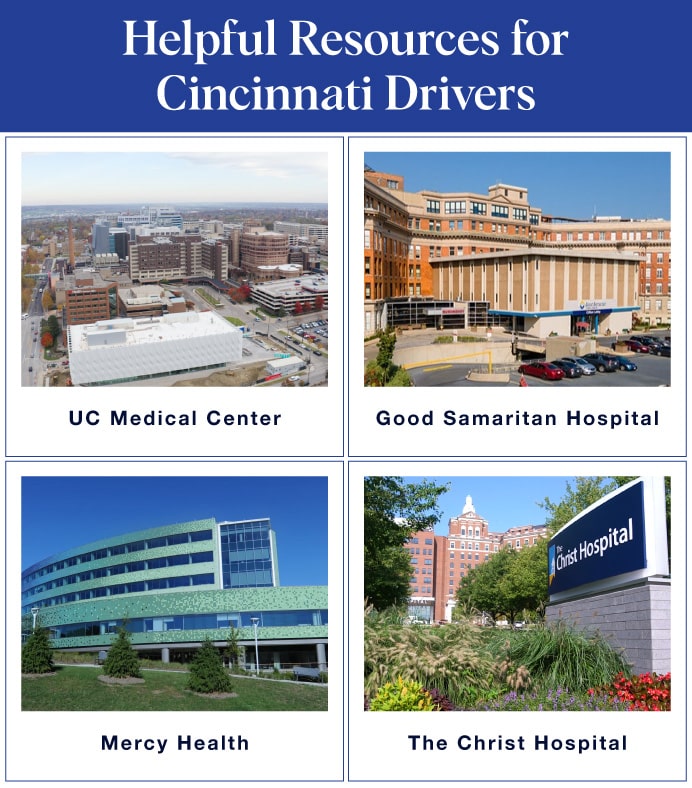If you’re driving around Cincinnati, you’ll come across heavy traffic, Ohio’s famous weather changes, and interstates that cross state lines. Being along the Kentucky border, Cincinnati has many commuters daily and is a hub for sporting and entertainment events. Keep yourself safe while you navigate Cincinnati roads. Lawrence & Associates helps injured people every day, and we want to help you spot problem areas so you can drive more confidently.
What to Know When Driving in Cincinnati
Cincinnati is a unique city, and this Cincinnati travel guide can help you plan your trip and stay safe while driving. Right outside Ohio’s Appalachia region and close to the Kentucky border, its roads and neighborhoods are full of hilly terrain and winding roads. Neighborhoods like Mount Adams, Clifton, and the Seven Hills areas are known for curving roads and steep hills, with stop signs waiting at the bottom.
Auto injuries can be even more common during snowy and icy weather, as the roads become more and more hazardous, driving with caution is crucial. Along with winter conditions making roads icy, springtime in Cincinnati can bring serious flooding. Do not drive through floodwater; even two feet of floodwater can carry away a vehicle.
Cincinnati is a busy city with universities, professional sports teams, and music venues. During rush hour, the interstates can get extremely congested, as can driving by the stadiums on game days or downtown.
I-71, I-74, I-75 and I-275 all cross between Ohio and the Kentucky border, linking the two states and staying busy with commuters driving between the states for work. These interstates also connect Louisville, Lexington, Dayton and Columbus.
Common Traffic Challenges in the Cincinnati Area
At the I-75 and I-74 split near downtown, there are often delays from traffic or construction. The Brent Spence Bridge is often congested, slowing traffic flow and compromising safety. A new companion bridge plan was announced, and a project is underway to improve eight miles of the interstate.
While on the highway, exits can get more confusing as you come into the city, and merging lanes are short, with quick merges necessary. This can be difficult to track while finding your exit and keeping yourself safe.
Drive defensively, like anticipating other drivers’ actions and remaining aware of the road. Maintain a safe distance from the vehicle ahead, use your turn signal, and don’t speed. Always follow the speed limit marked for construction zones.
Columbia Parkway and Fort Washington Way are examples of congested exits that cause many close calls. Do your best to match traffic speed, use your signal early, and take the first safe gap—don’t stop in the merge lane.
The older neighborhoods have winding roads with steep hills and sharp turns. Bridges ice before regular roads, and if you’re going over the river during the winter, you should be extra cautious. The Ohio River is also known for flooding, so it’s important to be aware of these risks and the day’s weather.
Cincinnati’s Most Dangerous Roads and Intersections
In June, the city of Cincinnati’s Safe Streets and Roads for All program took suggestions from the public on how to make the streets safer, based on 28 high-impact intersections. The city is working to make the roads safer, but drivers must also play their part to prevent car or truck accidents. Being aware of these factors can help everyone stay safer on the road.
Some of the high-risk areas, exits, and streets are:
- I-75 near the Hopple Street interchange: This interchange is known for accidents, difficult merging lanes, extreme backups during rush hour, and commercial trucks often use the interstate.
- I-71 near the Reading Road exit: This exit is known for getting backed up due to merging and exiting traffic, and multiple serious accidents have been reported in recent years. The Paddock Hills community has had 65 accidents in 2025.
- Glenway Avenue in Westwood: In 2023, a serious injury accident left the road closed for over four hours, and at least two accidents involving vehicles hitting pedestrians have been reported.
- Beechmont Avenue in Anderson Township: Five Mile Road and Beechmont Avenue have been a dangerous intersection for over a decade, and accidents with serious injuries are still common, as the neighborhood grows.
- Colerain Avenue in Northgate: Three of the street’s intersections were found to be included in a list of the most dangerous intersections in 2019, particularly at Virginia Avenue, North Bend Road, and West Galbraith, becoming congested during rush hour.
- Montgomery Road near Kenwood Towne Centre: Traffic is heavy near the shopping center and often backed up by customers trying to get to stores. A Kenwood Area Transportation Planning Study is currently underway to improve this area of the road.

Rules of Cincinnati and Ohio Roads
According to Ohio law, you cannot use your cellphone while driving and must be hands-free. At red lights, you can turn right if the light is red unless there is a sign saying you cannot. Always yield to pedestrians who are walking in a crosswalk.
You must drive at 20 mph while the lights are flashing in a school zone. Keep in mind that Ohio allows traffic cameras to catch speeding or red light runners, but with some limitations.
Roundabouts are gaining popularity in Ohio cities, such as Cincinnati and the surrounding areas. Vehicles in a roundabout travel counterclockwise, with entering traffic yielding the right of way to the circulating traffic. When a traffic signal is not operating, the intersection is treated like a four-way stop.
Move to the next lane when a vehicle with flashers is pulled over on any Ohio highway. If it’s unsafe to move over, slow down and proceed cautiously. Always pull over for emergency vehicles unless they are traveling in the opposite direction on a divided highway. Move over to the right of the road as much as possible until the emergency vehicle passes.
Many of Ohio and Kentucky’s traffic laws are similar, with some differences. One difference is the type of insurance. Kentucky is a no-fault (PIP) state, while Ohio is an at-fault state.
Tips for Safe Driving in Cincinnati
Always wear your seat belt and never drive impaired by alcohol or drugs. Be sure to obey speed limits and traffic signals, as speed limits can change in different areas of the interstate and slower speeds in the city.
Bird and Lime electric scooters are available to rent in Cincinnati, and drivers should watch out for e-scooters as much as they do bikers. Bikers must obey traffic laws, and drivers overtaking a bicycle must leave a safe distance, not less than three feet, until they’ve overtaken the bike. Motorcycles will also be out and driving during the warmer months.
Streets in Clifton and near the university are narrow and often busy, and pedestrians will always be walking in a city, especially downtown. Be aware of anyone walking, especially when turning onto a street.
Practice defensive driving by keeping a safe distance from other vehicles, scanning the road, and checking your mirrors. Even though there are strict laws about cell phones, it’s still important to stay alert for distracted drivers on the road.
Maintaining your vehicle also helps you stay safer on the road and avoid accidents or emergencies. If you’re planning a long drive, get enough rest to avoid driving drowsy and be aware of bad weather conditions.
Parking in Cincinnati—What to Know
If you’re driving to Cincinnati, figuring out where you’ll park your car can be stressful if you don’t consider parking beforehand. If you end up in the wrong parking spot or stay for too long, you might end up with a parking ticket that can put a damper on your trip.
Downtown offers many parking garages, surface lots, and metered parking spots. On-street paid parking is enforced from 8 a.m. to 9 p.m. Monday through Friday, 9 a.m. to 9 p.m. Saturday, and 2 p.m. to 9 p.m. Sunday. South of the river, there is free weekday parking from 9 p.m. to 8 a.m. Monday through Saturday and free on Sundays.
Residential streets and areas require parking permits, where you’ll need a residential parking pass to park on the street. Many streets have metered parking, which can be paid with a card, through the Cincy EZPark app, or with coins. There are also streets with a combination of residential and metered parking.
Parking rates depend on location, time of day, and special events. Monthly rates range from $25 to $150, and daily rates range from $1.50 to $15.
A great downtown parking garage is the Fountain Square North Garage, where Fountain Square holds free events weekly with restaurants and shops nearby. The Town Center Garage provides covered parking near music venues, the Cincinnati Ballet, city hall, and Washington Park. Washington Park garage is staffed 24/7 and open year-round, making it the perfect place to park when visiting the dog park or attending a special event.
When parking or driving in Cincinnati, remember the Bengals or Reds game schedule since there can be extra traffic. If you’re parking at Paycor Stadium, there are tailgates to look out for.
If you’re parking in the winter, choosing a covered parking garage might save you from needing to clear off your car. If you choose street parking during a snowy day, choose a parking spot you can easily get out of, preferably without having to back up into snow.
Always choose a well-lit parking spot in a populated area while parking at night. Always check parking signage on the curb or along the road before you leave your car. The street may have street sweeping during certain hours, or if a snowstorm is coming in, there could be a parking ban in place.
Helpful Resources for Cincinnati Drivers
Consider downloading the OHgo app for real-time traffic updates, route notifications, and live traffic cameras to view accurate delay times. It can be especially helpful during the unpredictable winter months.
Find your closest BMV office or BMV Express location to update your license, or visit the Hamilton or Clermont County Clerk of Courts for auto titles. If you’re ready to learn to drive as a teen or an adult, Cincinnati has multiple driver schools that offer teen driving courses or adult driver’s education.
After an accident, call 911 or the Cincinnati Police Department’s non-emergency number (513) 765-1212.
If you’re involved in an accident in Cincinnati, there are multiple hospitals to receive treatment, including:
- UC Medical Center: The area’s only verified Level 1 adult trauma center provides emergency care at its Clifton campus.
- Good Samaritan Hospital: Offering emergency medicine, TriHealth is the oldest health care facility in the area.
- Mercy Health: The Anderson Hospital Emergency Department is one of Mercy Health’s eight regions in Ohio and Kentucky, which it serves.
- The Christ Hospital: The Christ Hospital Health Network has two emergency room locations in the Cincinnati area and is a not-for-profit care facility.
You can easily find a trusted auto repair facility through AAA’s list of approved repair shops in Cincinnati.

Drive Smart in Cincinnati and Know Who to Call if You’re Hurt
Driving in a busy city can be stressful at any point, but especially when the city is new to you. Accidents can’t always be avoided, but if you are injured, you don’t have to face your recovery alone. Don’t let insurance underpay your claims; let our attorneys lead you to healing and justice.
At Lawrence & Associates Accident and Injury Lawyers, LLC, we understand the challenges you’re facing and are here to protect your rights every step of the way. Our experienced Cincinnati & Northern Kentucky personal injury attorneys can guide you on what to do and avoid so you don’t unintentionally harm your case.
Call us today in Ohio (513)951-6723 or Kentucky (859) 251-3045 for a free, confidential consultation, or fill out our online form to get started. Let us fight for the compensation you deserve while you focus on healing.
